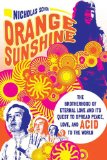When people hear the word LSD or the phrase “turn on, tune in, drop out,” a couple images likely come to mind. One is Timothy Leary, the most publicized advocate of LSD. Another is a group of spaced-out hippies in psychedelic clothing (often optional) at a “be-in.” What probably doesn’t come to mind is a smuggling operation responsible not only for bringing tons of marijuana into the country from Mexico, but manufacturing LSD and smuggling hashish from Afghanistan. Yet as Nicholas Schou explores in Orange Sunshine: The Brotherhood of Eternal Love and Its Quest to Spread Peace, Love, and Acid to the World, those were among the main activities of The Brotherhood of Eternal Love.
 The Brotherhood stemmed from a concept of a man named John Griggs. Griggs was a marijuana dealer in Laguna Beach, Calif., in the mid-1960s when he discovered LSD. Griggs quickly became an evangelist. Despite his somewhat shady background — and many members of the Brotherhood would have criminal records — Griggs quickly came to believe that LSD was the path to enlightenment, a sacrament by which to discover and commune with God. In fact, when Leary later took up with the Brotherhood, he called Griggs”the holiest man who has ever lived in this country.”
The Brotherhood stemmed from a concept of a man named John Griggs. Griggs was a marijuana dealer in Laguna Beach, Calif., in the mid-1960s when he discovered LSD. Griggs quickly became an evangelist. Despite his somewhat shady background — and many members of the Brotherhood would have criminal records — Griggs quickly came to believe that LSD was the path to enlightenment, a sacrament by which to discover and commune with God. In fact, when Leary later took up with the Brotherhood, he called Griggs”the holiest man who has ever lived in this country.”
Griggs gathered a tribe of followers who engaged in communal acid trips. Originally about a dozen members, the group grew, dubbing themselves the Brotherhood of Eternal Love and actually forming a church by that name. Griggs and a number of others were serious about spreading peace and love through acid. “We were experiencing a whole new viewpoint of life that was so beautiful and loving and caring of others and the whole world. We felt connected to the source of all life,” one early member relates in the book. But opinions differed. Owsley Stanley, one of the first and best known of the freelance makers of LSD, cursorily dismisses the Brotherhood, calling its members a “bunch of loose cannons on a ship of fools.”
Schou, a reporter for the OC Weekly, did a feature article on the Brotherhood in 2005. With Orange Sunshine he delves more deeply into the group, interviewing not only about a half dozen of the original members, several later members and law enforcement officers. Even if spreading peace, love and LSD to the masses was the Brotherhood’s goal, Schou leaves little doubt that its criminal activity was equally, if not more, widespread. Members of the group smuggled tons of marijuana in from Mexico and distributed millions of hits of acid. In fact, starting in 1967 the group would be responsible for the manufacture and distribution of millions more hits of a form of LSD with 200 times the regular dosage, an LSD tablet Griggs would call “Orange Sunshine,” Several members of the group also made repeated trips to Afghanistan to smuggle tons of hashish into the U.S. The book also suggests that members of the Brotherhood who ended up living on Maui after smuggling tons of marijuana into the state were responsible at least in part for the development of a strain of marijuana that came to be known as “Maui Wowie.”
Some of the smuggling reflected a blend of two California cultures. Many of the prominent Brotherhood members were surfers. Surfboards often became the mechanism for smuggling marijuana, hash or LSD across borders. In fact, not only does one of those surfboards appear in the Jimi Hendrix film Rainbow Bridge that was shot on Maui, members of the Brotherhood appear in the movie.
Orange Sunshine seems less focused than Schou’s prior book, Kill the Messenger: How the CIA’s Crack-Cocaine Controversy Destroyed Journalist Gary Webb but there are a few reasons for that. First, this is a far broader subject involving dozens and dozens of individuals. Additionally, many who were involved in the Brotherhood remain reluctant even today to talk about it and its activities. In fact, it is perhaps surprising how many people agreed to be interviewed by Schou, although as the book occasionally notes, the arrangements for some interviews were rather unique. Yet all this leaves the book feeling a bit amorphous at times and it is at times difficult to track the various alliances within and associated with the organization.
Whether the Brotherhood was as massive a drug smuggling operation as its members claim or the book suggests, there is little doubt it was a major cartel. Law enforcement cracked down on the Brotherhood on August 5, 1972, arresting 57 persons associated with it and confiscating two and a half tons of hash, 30 gallons of hash oil and 1.5 million tablets of Orange Sunshine. Following the busts, Rolling Stone called the group the “Hippie Mafia.” Since its inception, the Brotherhood had clearly moved from its goals of enlightenment to to a commercial drug dealing enterprise. In some ways, that transformation could be viewed as mirroring the transition of the 1960s to the 1970s, Certainly, the cry of “”turn on, tune in, drop out” had already rung hollow by then.
Orange Sunshine may not be the definitive book on LSD culture of the 1960s. Still, it provides insight into an aspect of that milieu and counterculture with which few are familiar.
Put simply, surfing, smoking pot and dropping acid in Maui were the three things the Brotherhood enjoyed more than smuggling.
Nicholas Schou, Orange Sunshine







